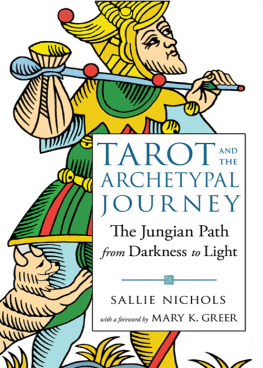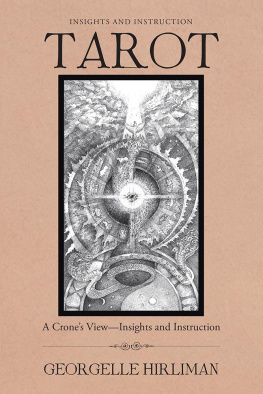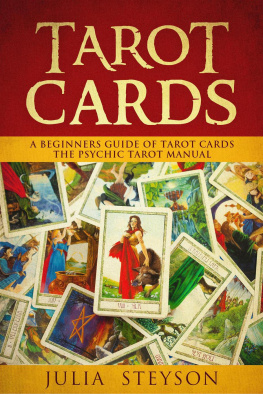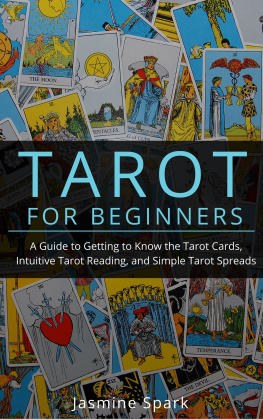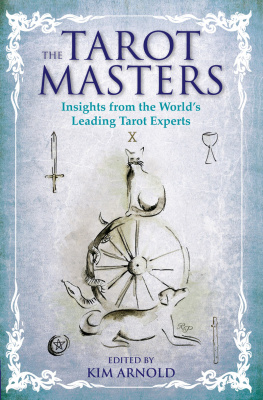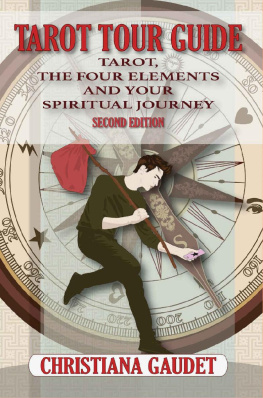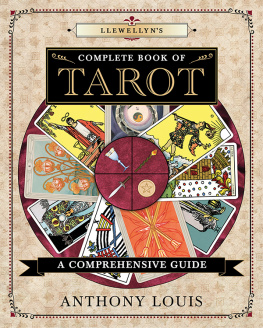

To
Culver Nichols
My thanks to the following friends who helped launch this Tarot Trip, and without whose advice and encouragement our ship would never have made home port: Janet Dallett, Rhoda Head, Ferne Jensen, James Kirsch, Rita Knipe, Claire Oksner, Win Sternlicht, William Walcott, and Lore Zeller.
This edition first published in 2019 by Weiser Books,
an imprint of
Red Wheel/Weiser, LLC
With offices at:
65 Parker Street, Suite 7
Newburyport, MA 01950
www.redwheelweiser.com
Copyright 1980, 2019 by Sallie Nichols
Foreword copyrighgt Mary K. Greer
All rights reserved. No part of this publication may be reproduced or transmitted in any form or by any means, electronic or mechanical, including photocopying, recording, or by any information storage and retrieval system, without permission in writing from Red Wheel/Weiser, LLC. Reviewers may quote brief passages. Pages 393-394 constitute the continuation of this copyright page. Previously published in 1980 as Jung and Tarot by Weiser Books, ISBN: 978-0-87728-515-1.
ISBN: 978-1-57863-659-4
Library of Congress Cataloging-in-Publication Data
available upon request.
Cover design by Kathryn Sky-Peck
Printed in Canada
MAR
10 9 8 7 6 5 4 3 2 1
www.redwheelweiser.com/newsletter
Contents
List of Illustrations
Foreword
It was with great excitement that I first bought Jung and Tarot: An Archetypal Journey, the original title of this book, when it came out forty years ago. I've since read it several times. On rereading it now, I realize how many influential ideas about the cards I first encountered here.
I like to think that Jung and Tarot is the book Carl Jung would have written had he had time. It is not a book detailing Jungian concepts, although Nichols mentions them when relevant, nor does it seek to teach how to use tarot in Jungian analysis, although you'll find recommended exercises and examples of Nichols' readings for herself and her clients.
This is a book about archetypes, specifically as they are embodied in the Major Arcana. It demonstrates how these cards are analogous to myths and artistic works as well as contemporary cultural figures and movements that reflect the forces working in an individual's own inner psyche and life condition. Moreover, Nichols demonstrates how to approach any tarot deck via the archetypes using Jung's methods of word association, active imagination, and dialogue.
I was drawn to tarot in college in 1967 via the Rider-Waite-Smith deck precisely because it displayed the archetypal symbolism and ideas of Jung and Joseph Campbell with which I had recently become familiar. By 1980, I had been teaching tarot in colleges for seven years. I welcomed the arrival of this book for it spoke my language, even though we favored different tarot decks. Since then I've written eight books on tarot and I teach it around the world. As a member of a Jungian-based book group that met three times a month for over 20 years, I've continued with my own studies of Jungian materials and perspectives, always relating them to tarot.
Nichols has left us a Jungian approach to tarot in the manner of some of the greatest expositors of the Jungian canon such as Marie-Louise von Franz, M. Esther Harding, and Robert Johnson, among so many more. She is a master of Jung's technique of amplificationthat is, seeing what is behind an archetypal image or symbol by enlarging and viewing it from different perspectives, restoring it to its original fullness to discover what kind of forces could be working in it.
Although not trained as a psychoanalyst, Nichols went to Zurich several times for her own analysis and to attend lectures with Jung, his wife, Emma, and others. For five years she was associate editor of Psychological Perspectives: A Quarterly Journal of Jungian Thought, the publishing arm of the C.G. Jung Institute of Los Angeles. Nichols worked on her own book from 1974 to 1980, during which she presented many of the chapters on the Major Arcana as lectures at the Institute. She was also a professional tarot reader, reading in what today we might call a therapeutic or personal insight manner rather than predictive fortune-telling.
Nichols, a native Californian living in Palm Springs, died soon after the book was published. Shortly before writing the foreword to this new edition, I was able to interview Claire Cohn (formerly Oksner) who knew her. She described Sallie Nichols as being intensely fun-loving and possessing a wild sense of humor and joy in life, as well as being very inquisitive, wise, gracious, and absolutely serious when working. Cohn remembered Nichols and Laurens van der Post, who wrote the book's introduction, roaring with laughter together during some event. Nichols could also be enormously compassionate, intuitively knowing just when someone needed a boost. She lived the tarot and loved it, viewing the cards as being like real people. In her late 60s, while writing this material, Nichols, as becomes apparent, was vitally interested in the cultural revolution taking place in 1970s America and in the experiences of the young.
The manuscript was rejected by all the publishers to whom Nichols submitted it. It was Claire Cohn (former director of the Los Angeles Jung Institute bookstore, library, and picture archive) who hand-carried the manuscript to New York and to Samuel Weiser where its value was finally recognized. No editing was required as it was deemed perfect as-is! Nichols inscribed in Claire's copy of the book, To our slick chick who carried my manuscript from the dark core of introversion into the glare of Broadway and gave it life.
Nichols' purpose was to examine the twenty-two trumps in sequence in order to puzzle out their story of the age-old path to self-realization. She focused on the essence of each card's importance for us, as it reflects and reveals the most profound levels of the human psyche. To do this, she chose the Marseille deck, because it transcends the personal, as if the cards erupted spontaneously with no creator and no text. Like the alchemical images of the Mutus Liber or Silent Book, it offers a song without words, stimulating the imagination, evoking feelings and insights that call for an understanding of the effect of symbols on the psyche.
This book plunges us into the messy and even chaotic realm of the unconscious in which there is no end to a symbol's meaning, where all the figures of the tarot have their own kind of power, and this power is active in us. Nichols thus invites us to approach the cards as we would a dream, purposefully projecting our inner world into the outer through the cards in order to know ourselves.
In making the tarot relevant to her time, Nichols sometimes views the ageless archetypal symbols in terms of cultural examples from the 1970s that may occasionally appear irrelevant or old-fashioned. Remember, these descriptions are merely springboards for the imagination. For example, Nichols equates the Fool with a carefree wandering hippie. Half a century later, we're more likely to view the Marseilles Fool as a homeless person. She sees the Papesse as sacrificing wedded security to follow one's vocation while enduring loneliness and humiliation. A 21st century person might prefer to see this powerful image of the feminine as a classic introvert who values intuition and inner work over outer-focused interactions and rational modes of perception. Stop and notice when you have a strong emotional reaction to the text in this book, and ask, Given my life, what would be a most relevant example of this archetype?
Next page
